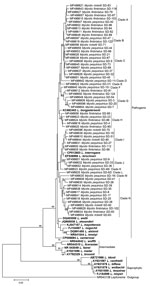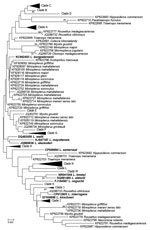Volume 24, Number 6—June 2018
Dispatch
Pathogenic Leptospira Species in Insectivorous Bats, China, 2015
Abstract
PCR amplification of the rrs2 gene indicated that 50% (62/124) of insectivorous bats from eastern China were infected with Leptospira borgpetersenii, L. kirschneri, and several potentially new Leptospira species. Multilocus sequence typing defined 3 novel sequence types in L. kirschneri, suggesting that bats are major carriers of Leptospira.
Leptospirosis is a zoonotic disease caused by the pathogenic spirochetes of the bacterial genus Leptospira (1). Although leptospirosis is mainly prevalent in tropical and subtropical countries (2), it is considered an emerging or reemerging zoonosis of global public health concern (1). In China, leptospirosis is listed as a category B notifiable disease (3). Globally, rodents are recognized as important reservoir hosts (4); however, a growing number of studies highlight the potential role of bats in the epidemiology of Leptospira (4). So far, knowledge on Leptospira in bats in China is lacking. Therefore, we screened archived bat kidney samples for Leptospira species to evaluate the potential role of bats in the ecology of Leptospira in China.
During July–October 2015, we captured 124 insectivorous bats with nets in Mengyin County, Shandong Province, China; the bats were initially intended for viral metagenomic analysis. Details regarding anesthetization of bats and tissue sampling were described previously (5). We collected the kidneys, storing them at −80°C until analysis. We identified bat species by using PCR amplification and DNA sequencing of the cytochrome B (cytB) gene as described previously (6). The 124 bats were classified into 4 species of the Vespertilionidae family (26 Eptesicus serotinus bats from 2 farmers’ houses, 30 Myotis fimbriatus bats and 10 M. ricketti bats from a city sewer, and 58 Myotis pequinius bats from a karst cave).
We designated bat kidney samples by using the abbreviation of Shandong plus the sample identification number (e.g., SD-49). We extracted DNA from bat kidney samples by using QIAamp DNA Mini Kit (QIAGEN, Hilden, Germany), according to the manufacturer’s instructions. To identify the species of Leptospira in bats, we amplified the 16S rRNA gene (rrs2) by using nested PCR with primers Lepto 16S-1st-F, Lepto 16S-1st-R, Lepto 16S-2nd-F, and Lepto 16S-2nd-R (7). We cloned the rrs2 PCR products (642 bp) into the pMD 19-T vectors (TaKaRa, Shiga, Japan) and randomly picked 1 colony for Sanger sequencing using M13 universal primers on both DNA strands.
On the basis of rrs2 amplification results, 62 (50.0%) of 124 bats tested were positive for Leptospira. All the E. serotinus bats (0/26, 0.0%) were negative for Leptospira, whereas the M. fimbriatus bats (19/30 [63.3%]), M. ricketti bats (6/10 [60.0%]), and M. pequinius bats (37/58 [63.7%]) showed high rates of infection.
Using ClustalW with MEGA 7.0 (http://www.megasoftware.net), we aligned the rrs2 sequences from this study with reference Leptospira species downloaded from GenBank. We constructed a neighbor-joining phylogenetic tree (also by using MEGA 7.0) (8). On the basis of the rrs2 phylogeny, all Leptospira detected in bats in Mengyin County clustered into the pathogenic group and could be divided into >14 clades (clades A–N). Although clade H was most likely associated with L. borgpetersenii, the Leptospira detected in bats in Mengyin County were divergent from any known Leptospira species (Figure 1) and any previously published Leptospira sequences from bats (Figure 2); therefore, these organisms might represent potentially new Leptospira species. We deposited the 62 rrs2 sequences of Leptospira in the Mengyin County bats into GenBank (accession nos. MF498596–657).
To characterize the Leptospira species detected in bats from Mengyin County, we attempted multilocus sequence typing (MLST) on 7 housekeeping genes (glmU, pntA, sucA, tpiA, pfkB, mreA, and caiB), as previously described (9). We assigned alleles for all 7 loci by using a publicly available Leptospira MLST website (https://pubmlst.org/leptospira) and defined sequence types (STs) by using the allelic profiles (glmU-pntA-sucA-tpiA-pfkB-mreA-caiB).
Because we conducted MLST using kidney DNA rather than DNA from isolates, the results were arduous to obtain. Only 35 of the 62 rrs2-positive bats were successfully amplified for >1 gene. For three samples, SD-49, SD-88, and SD-112, all 7 loci were obtained. We uploaded the allele data to the Leptospira MLST database and assigned a novel allele number for each gene (Technical Appendix Table). According to the allelic profiles, we classified the organisms as L. kirschneri, assigning all 3 with novel STs (ST244 for SD-49, ST246 for SD-88, and ST245 for SD112).
We obtained 32 incomplete allelic profiles in all. After searching the Leptospira MLST database for each gene, we found that the loci of this study could not match with any known alleles and that they represented novel alleles; however, novel alleles could not be assigned for incomplete allelic profiles. Phylogenies based on each of the 7 genes showed inconsistent topologies for individual bats, indicating co-infection with different Leptospira species in the Mengyin County bats (Technical Appendix Table, Figures 1–7). For SD-103, for example, we amplified 5 of the 7 genes. On the basis of glmU, tpiA, pfkB, and mreA, SD-103 clustered with L. borgpetersenii; however, on the basis of sucA, SD-103 fell into the group of the potentially new Leptospira sp. 2.
Because we did not conduct culture isolation with the archived bat kidney samples, further isolation with fresh bat kidney or urine samples will be needed to enable a thorough genotyping analysis of Leptospira species in the Mengyin County bats. Altogether, our study suggested that bats in Mengyin County carried a wide diversity of Leptospira, and the actual genetic diversity is likely even higher.
In our study, all the E. serotinus bats were negative for Leptospira, whereas M. fimbriatus, M. ricketti, and M. pequinius bats showed a high rate of infection. This finding might be explained by a widely accepted belief that Leptospira mainly circulate in humid environments (10). E. serotinus bats were captured from the eaves of 2 farmers’ houses, where the habitats were dry, whereas the M. fimbriatus, M. ricketti, and M. pequinius bats were sampled from the humid city sewer and karst cave.
So far, Leptospira has been detected in ≈50 bat species belonging to 8 bat families from tropical and subtropical regions as well as part of Europe (4). Although the role of bats as carriers of Leptospira associated with human leptospirosis remains uncertain, intrusion into bat habitats and increasing urbanization that results in the cohabitation of bats and humans are likely to increase the opportunity for batborne Leptospira spillover (11). Moreover, bats might play an important role in the epidemiology of Leptospira through transmission between bats and rodents, with rodents being a major source of human infection (12).
Myotis spp. bats in Mengyin County in Shandong Province of China showed a high rate of infection with Leptospira borgpetersenii, L. kirschneri, and several potentially new Leptospira species, suggesting that bats are important carriers of Leptospira in Mengyin County. To date, knowledge of batborne leptospirosis is lacking, and the monitoring of the potential spillover of batborne Leptospira to humans is needed.
Ms. Han is a PhD candidate in the School of Health Sciences, Wuhan University. Her research interests include emerging infectious diseases and vectorborne diseases, especially batborne diseases.
Acknowledgment
The collection of bats for microbiologic studies was approved by the Ethics Committee of Prevention Medicine of Shandong University (approval no. 20150501). Bats were captured with the help of the Mengyin County Center for Disease Control and Prevention. This study was supported by a grant from the National Natural Science Funds of China (grant no. 31570167).
References
- Adler B. History of leptospirosis and Leptospira. In: Adler B, editor. Leptospira and leptospirosis. Berlin, Heidelberg: Springer Berlin Heidelberg; 2015. p. 1–9.
- Pappas G, Papadimitriou P, Siozopoulou V, Christou L, Akritidis N. The globalization of leptospirosis: worldwide incidence trends. Int J Infect Dis. 2008;12:351–7. DOIPubMedGoogle Scholar
- Hu W, Lin X, Yan J. Leptospira and leptospirosis in China. Curr Opin Infect Dis. 2014;27:432–6. DOIPubMedGoogle Scholar
- Dietrich M, Mühldorfer K, Tortosa P, Markotter W. Leptospira and bats: story of an emerging friendship. PLoS Pathog. 2015;11:e1005176. DOIPubMedGoogle Scholar
- Han HJ, Wen HL, Zhao L, Liu JW, Luo LM, Zhou CM, et al. Novel Bartonella species in insectivorous bats, northern China. PLoS One. 2017;12:e0167915. DOIPubMedGoogle Scholar
- Linacre A, Lee JC. Species determination: the role and use of the cytochrome b gene. Methods Mol Biol. 2016;1420:287–96. DOIPubMedGoogle Scholar
- Ogawa H, Koizumi N, Ohnuma A, Mutemwa A, Hang’ombe BM, Mweene AS, et al. Molecular epidemiology of pathogenic Leptospira spp. in the straw-colored fruit bat (Eidolon helvum) migrating to Zambia from the Democratic Republic of Congo. Infect Genet Evol. 2015;32:143–7. DOIPubMedGoogle Scholar
- Saitou N, Nei M. The neighbor-joining method: a new method for reconstructing phylogenetic trees. Mol Biol Evol. 1987;4:406–25.PubMedGoogle Scholar
- Boonsilp S, Thaipadungpanit J, Amornchai P, Wuthiekanun V, Bailey MS, Holden MT, et al. A single multilocus sequence typing (MLST) scheme for seven pathogenic Leptospira species. PLoS Negl Trop Dis. 2013;7:e1954. DOIPubMedGoogle Scholar
- Ivanova S, Herbreteau V, Blasdell K, Chaval Y, Buchy P, Guillard B, et al. Leptospira and rodents in Cambodia: environmental determinants of infection. Am J Trop Med Hyg. 2012;86:1032–8. DOIPubMedGoogle Scholar
- Hayman DT, Bowen RA, Cryan PM, McCracken GF, O’Shea TJ, Peel AJ, et al. Ecology of zoonotic infectious diseases in bats: current knowledge and future directions. Zoonoses Public Health. 2013;60:2–21. DOIPubMedGoogle Scholar
- Matthias MA, Díaz MM, Campos KJ, Calderon M, Willig MR, Pacheco V, et al. Diversity of bat-associated Leptospira in the Peruvian Amazon inferred by bayesian phylogenetic analysis of 16S ribosomal DNA sequences. Am J Trop Med Hyg. 2005;73:964–74.PubMedGoogle Scholar
Figures
Cite This ArticleOriginal Publication Date: May 03, 2018
Table of Contents – Volume 24, Number 6—June 2018
| EID Search Options |
|---|
|
|
|
|
|
|


Please use the form below to submit correspondence to the authors or contact them at the following address:
Xue-Jie Yu, School of Health Sciences, Wuhan University, Wuhan 430071, China
Top